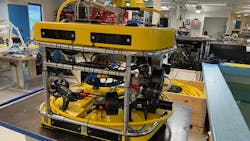New robotic, digital technologies helping to improve asset inspection, repair
Editor's note: This story first appeared in the July-August 2022 issue of Offshore magazine. Click here to view the full issue.
By Danny Constantinis * EM&I Group
Following the downturn, pandemic, bankruptcies, amalgamations, and geopolitical turmoil, the drilling sector has finally ‘bounced back’ with thousands of new wells needing to be drilled.
Keeping drilling assets operational with the minimum downtime or off hire time will be critical for efficient operation in future. This is where diverless and remote methods of inspection and maintenance will help, both to keep assets operational and to enable ‘warm stacked’ and ‘cold stacked’ assets to become operational swiftly and without downtime for class inspections.
EM&I’s robotic and digital asset integrity technologies have played a key role in improving the safety, efficiency, and economy of inspection and repair as a result of the company’s participation in the HITS (Hull Inspection Techniques and Strategy) Joint Industry Project.
This HITS joint venture project has produced a number of ground-breaking, industry-driven innovations including the ODIN range of diverless underwater inspection and repair methods. These range from UWILDs (under water inspection in lieu of drydocking), inspection and repair of MODU hulls, valves, structures, sea chests, and mooring systems, with more than 200 projects successfully completed for many of the leading drilling companies throughout the world.
ODIN was developed by EM&I and was encouraged by the influential HITS JIP whose membership includes the major class societies (ABS, LR, BV and DNV) and many of the world’s major operators and leasing organizations.
Robotic inspections are already becoming even more ‘remote’ with live streaming of data to onshore surveyors and engineers are already available, leading to further safety, cost, and operational benefits. This also helps to reduce POB to a minimum and means that onshore specialists can direct the technical and operational work in a ‘low-cost low-risk’ environment.
Until recently only a small percentage of the data has been used to demonstrate regulatory or class compliance. This is changing fast – the ability to store, analyze and aggregate data and metadata is proving to be a great opportunity for being able to trend asset condition, plan remedial work and even improve design.
Two recent case studies illustrate the benefits of employing these technologies. In one case,
ODIN technology was used for critical valve inspections and repairs on a drillship operating off the coast of Angola, while the vessel was on hire, on station, and in operation. Twenty-one valves were inspected and three repaired, safely, on time, and at a fraction of the cost of conventional methods.
ODIN uses specially adapted cameras and manipulators, inserted through class approved ODIN access ports, installed adjacent to the valves to be inspected. The ODIN repair technology was also used to isolate three valves that needed to be repaired using a double block inflatable bladder isolation system, inserted through ODIN access ports.
All the work was carried out without using divers and with no loss of uptime. Both the client and the class society were pleased with the results, with a 10/10 FPAL award (client feedback assessment system) for this project.
The benefits of using the ODIN system included avoiding the off-hire time of around 10 days that a dive team would entail, around a 50% cost reduction, and a 70% POB reduction. A further benefit is that the ODIN access ports can also be used again for all subsequent valve inspections.
Another case involved a Bureau Veritas classified semisubmersible drilling rig, operating off the coast of Malta. The rig needed to undergo its five-year periodic UWILD and carry out essential valve inspection, repair work and additional structural inspections while the asset was in operation and on hire. The client chose to use EM&I’s ODIN technology to avoid off-hire time, reduce costs, and enhance safety by eliminating diving operations.
Inspection of confined spaces was achieved with minimal or no man entry, again using a combination of ROC (remotely operated cameras), laser scanning and advanced NDT methods.
The workscope on the asset was made up of four phases:
1. In-water cleaning and inspection of the pontoons, columns, and structures.
2. General visual and close visual inspection with thickness measurement of the internal structure of the columns, pontoons, topsides, and external structures.
3. Internal inspection and function test of critical isolation valves whilst in operation.
4. Replacement of a 10-in. sea chest gate valve, with no down time or divers.
All the work was carried out while the asset was on station and in normal operation, with no downtime or loss of earnings.
The cost saving target for EM&I innovations was well in excess of 50%, and that in this case the class society were fully satisfied with the work, and the client awarded EM&I a 10/10 FPAL (the established client assessment system) rating for this project.
The ODIN diverless UWILD technology has now been proven on over 200 projects, on drillships, semisubmersibles, jackups, and FPSOs throughout the world with great success.
The author
Danny Constantinis is Executive Chairman & CEO of the EM&I Group, based in Malta.
